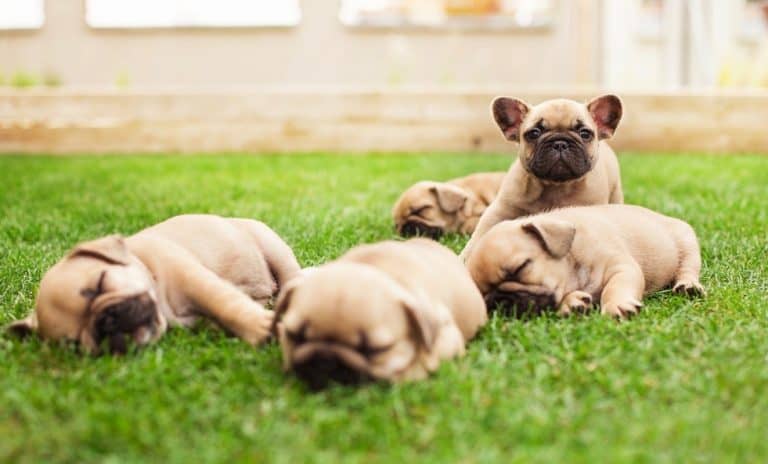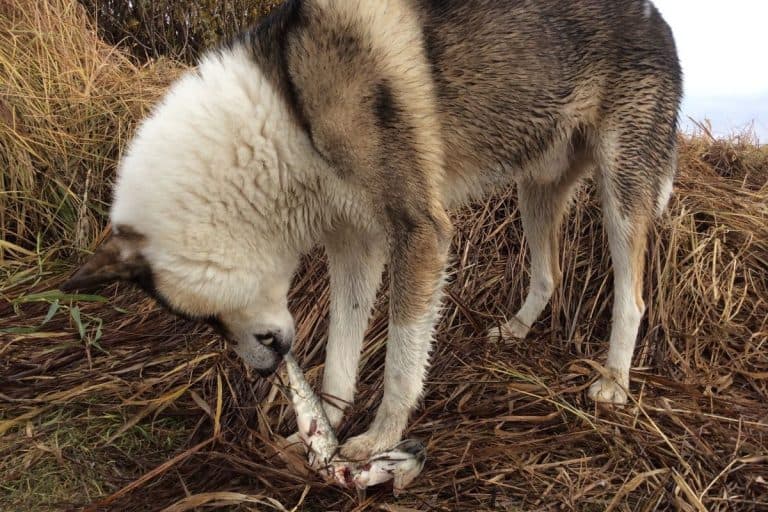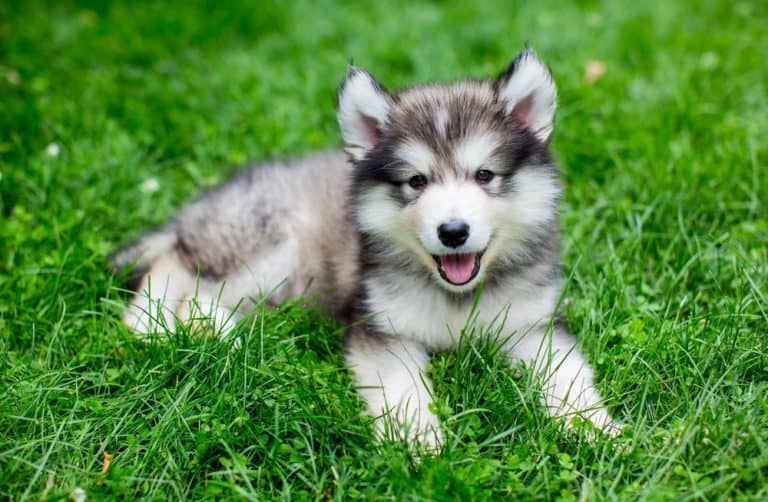Husky Growth Chart (Weight & Size Chart) – When Do Huskies Stop Growing?
Siberian huskies aren’t really all that big. In fact, they’re classed as mid-sized dogs. If you’re raising a husky puppy for the first time, you’ll enjoy watching your pup grow.
Our husky growth chart will help you to follow its progress – but just when do huskies stop growing?
Like human children, puppies are inclined to “stretch” first and then fill out. So the question of growth depends on whether we’re looking at height or weight.
When Do Huskies Stop Growing?
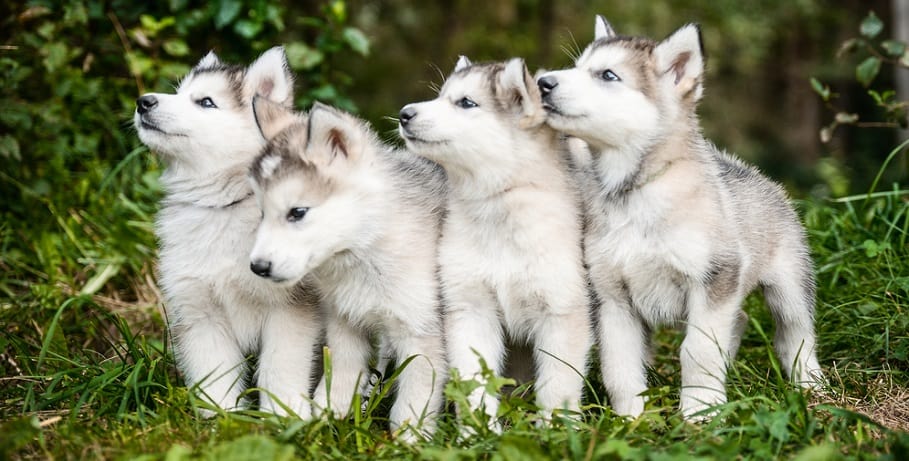
Siberian huskies reach their full height at about 12 months old, but they still have some weight to gain before they have reached their adult bulk.
By the age of 15 months, your husky has bulked out to fill its frame, but muscle development continues, and some dogs will still be gaining healthy bulk up to the age of about 36 months.
Females don’t get as bulky as males and usually have reached full adult weight at 2 years. How long do huskies grow? As you can see, there are different ways to look at the question. But if we are talking about height rather than weight, 12 months is a fair answer to give.
Husky Weight Chart
There are tons of reasons why you should be interested in your Siberian husky puppy’s weight. As a good pet parent, you’ll be wondering if you’re getting feeding right – you won’t want your pup to be over or underweight.
You also need to know the weight of your pup for certain pet care products and medications.
| Male Weight Range | Female Weight Range | |
|---|---|---|
| Age | Male Husky | Female Husky |
| 2 Months | 10 - 15 lbs / 4.5 - 6.8 kg | 8 - 12 lbs / 3.5 - 5.5 kg |
| 3 Months | 23 - 30 lbs / 10 - 14 kg | 18 - 30 lbs / 10 - 14 kg |
| 6 Months | 33 - 43 lbs / 15 - 19 kg | 26 - 36 lbs / 12 - 17 kg |
| 9 Months | 40 - 53 lbs / 17 - 24 kg | 33 - 46 lbs / 14 - 21 kg |
| 12 Months | 43 - 57 lbs / 19 - 26 kg | 34 - 49 lbs / 15 - 22 kg |
| 15 Months | 45 - 60 lbs / 20 - 27 kg | 35 - 50 lbs / 16 - 23 kg |
While weighing pups can be tricky if you don’t have a specialized scale, you can make an educated guess using our Husky growth chart above.
And, if you’ve mastered the art of standing on your bathroom scale with the pup in your arms, getting your combined weight before subtracting yours, you can be fairly precise and use the chart to make sure that development is progressing as it should.
Female Huskies are smaller and daintier than males, so do be sure to use the Siberian Husky size chart accordingly.
The puppy’s age in months is listed in the left-hand column and the normal weight range for male and female puppies is shown in the columns to the right of that. Simply match age to weight and gender, and you have the answers you’re looking for.
Weight is more important than height, but if you want the height estimate too, you can easily get it by doing what dog owners love best: petting your pup. When he is in a standing position, rub his shoulders (he’ll love it) and compare that to your body dimensions.
For example, if you know that your pup is now knee-high, it will be easy to measure the height of your knees from the ground.
Remember to check your puppy’s height at the shoulder and not the head. This is the measurement that is generally used when we talk about height in animals.
Husky Growth Chart: What To Expect

Pups grow fast, so they pass through their developmental stages quite quickly. In general, we can follow their development through the phases listed below.
Birth – 2 Weeks
During the time immediately following birth, all puppies, including Siberian huskies, can neither see or hear. Their eyes are tightly closed, and even their internal organs are still developing.
Mommy dog’s milk is vital to ensure that the puppies develop properly, and they are not ready for any other form of nutrition.
As you’d expect from such tiny puppies, they are not yet ready to play around and be active. They’ll squirm about feeling for Mom, but they are not yet able to interact with you or their littermates. From about two weeks to four weeks, their eyes will begin to open to the wide world.
3 Weeks – 8 Weeks
The cuteness factor starts to enter the equation as the puppies’ eyes begin to open and they take their first clumsy steps.
The doggie mom will take good care of her pups now, but do endure that they can’t wander off into the great outdoors when she isn’t being vigilant.
Your pups will begin making their first sounds too, and their hearing will be developing well. But they are still babies in every way and are by no means ready for any solid food. Once again, the doggie mom is the nutritionist who ensures her pups get everything they need.
If your nurturing instincts are getting stimulated by all this cuteness, direct them towards Mommy dog. She will need good food and good health in order to provide her puppies with everything they need.
8 Weeks – 20 Weeks
From about 8 weeks, your Siberian Husky puppies will be getting very lively and adventurous. Your role during this vital timeframe will be of paramount importance if you want your pup to develop healthy habits when socializing with people and other animals.
While your supervision (and love) will be important, don’t be overprotective. That can lead to panic biting when the dog is fully grown. Only intervene in interactions with other animals if it is absolutely necessary.
Siberian Huskies should have robust, fearless personalities, and being overprotective can lead to the pup never overcoming irrational fears and responding inappropriately in stressful situations.
Your pup will also have begun the weaning process, but should still be allowed to drink from Mommy Husky. Use our Husky puppy weight chart as an indicator to judge whether this is going smoothly.
Although some people say that puppies can be homed at 6 weeks, it is too young. 8 weeks is the absolute minimum age for adoption, and if the pups can stay with their mom for a few more weeks, it will be even better.
3 Months – 6 Months
Once pups arrive in their “forever homes,” and in the growth phase that lasts till about 6 months of age, socialization becomes even more critical. Do invite other people to your home to meet your pup, and take it for puppy playtime with other dogs.
Contact with other types of animals will be important too. Siberian Huskies have a very strong hunting instinct. You probably won’t train it out of them completely, but helping them to experience new people and other animals will help to avert at least some of the possibly unpleasant incidents that would otherwise arise.
During this phase, you will also begin obedience training. It is an essential, not only for your family’s convenience and comfort, but also for your dog’s safety.
6 Months – 12 Months
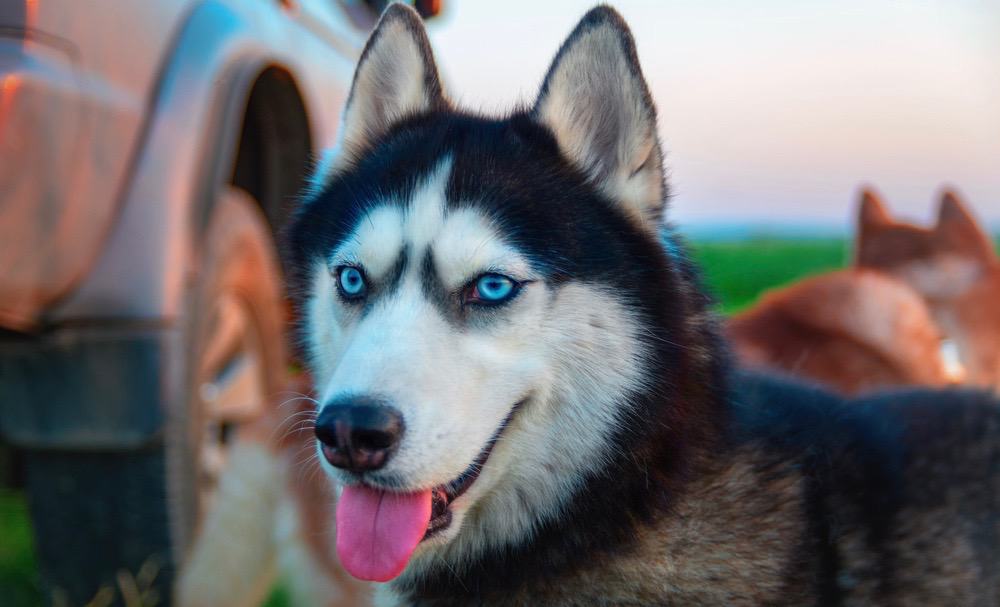
Although you may be considering spaying or neutering (unless you want to breed your dogs) at 6 months of age, your Siberian Husky pup is by no means an adult yet. He or she is still growing and learning, and you can expect your boundaries to be tested.
However, although you shouldn’t tolerate bad behaviors, remember that your Husky is still just a puppy. It will need lots of play and stimulation – bored, lonely pups will often resort to naughtiness to get attention or just a bit of entertainment.
Dog-walking will be an important part of your routine, and ideally, this should occur more than once a day and include a brisk trot. Times of the day will also be helpful in developing your Husky’s personality and ability to be a good companion.
Adult
From the age of 12 months to three years, your Husky pup is the equivalent of a human teenager. There’s still much of the puppy boisterousness to contend with, and there’s still time to work on any behavioral issues that may have cropped up.
If you played your cards right from the start, you will have a beautiful adult dog who fits in well with the rest of your family, and who will welcome your friends when they come to visit.
However, do remember that huskies were originally bred to be working dogs, and as such, they need a lot of exercise.
Husky Size Chart (Male vs Female)
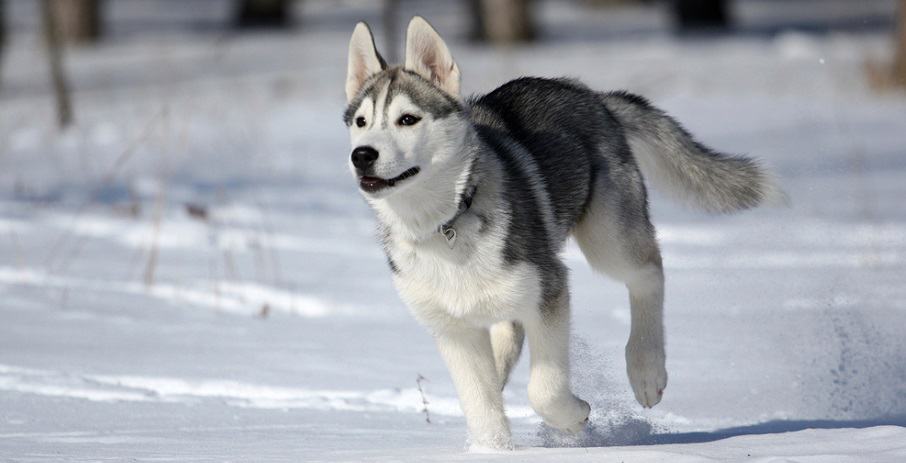
Husky males are bulkier and bigger than their daintier female counterparts. That means that the males will be both taller and heavier.
While male huskies reach a height of 21-24 inches (54–60 cm), females have an average height of 20-22 inches (50-56 cm).
This, in itself, may not sound like a big difference, but the additional weight of the male husky, combined with his bigger stature make for quite a significant difference in overall size. The average weight of a male husky is 44-60 pounds (20-27 kg) while the average for females is 35-51 pounds (16-23 kg).
Alaskan Malamute vs Husky Size
The size difference between a Husky and an Alaskan Malamute is clear as it is a choice between a medium-sized and a large dog. Alaskan Malamute is visibly bigger than a Husky.
On average, an adult Alaskan Malamute weighs between 75 and 85 pounds and stands at a height of between 22 and 26 inches. On the other hand, an adult Husky weighs between 35 and 60 pounds and has a height of between 20 and 24 inches.
Will Neutering/Spaying Affect My Husky’s Growth?
Neutering is where the male dog’s testicles are removed surgically while spaying is the removal of the female dog’s uterus and ovaries through surgery. Most Husky owners will have their puppy neutered or spayed at the age of 6 months.
Neutering your Husky reduces their aggression, sexual desire, and ‘male’ behavior but it can lead to weight gain, hypothyroidism, and bone problems. On the other hand, spaying reduces the heat period, lowers the risk of cancer, and prevents pregnancy but can lead to cancer and other health complication.
If your Husky is spayed or neutered at an early age, their growth plate can be affected which delays its closure. This causes your puppy to grow taller than they should and might experience joint problems in the future.
When Is a Husky Fully Grown?
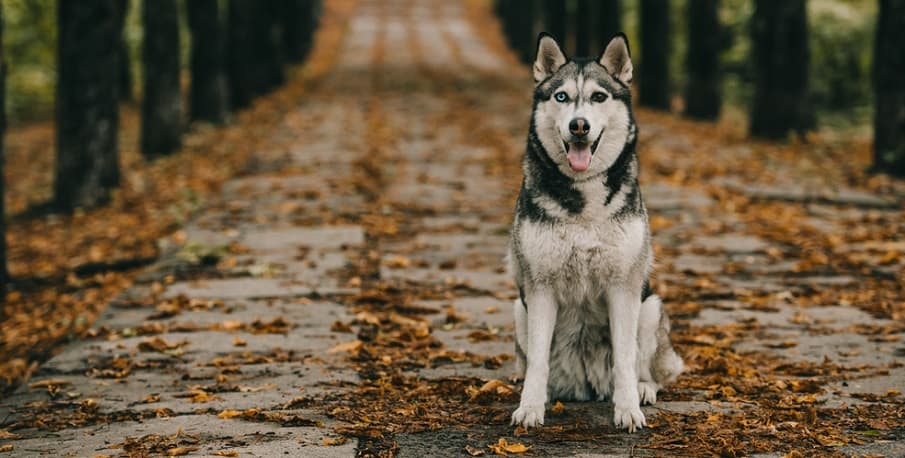
Certain factors affect the growth of Huskies such as genetics, nutrition, health, and physical activity. However, if your Husky is healthy, expect them to reach their fully grown weight and height at the age of 12-15 months.
Huskies will continue growing until about the age of 15 to 18 months. This growth is to allow filling out of your Husky’s already established body frame and form.
How Big Will My Husky Puppy Get?
Looking at the parents of your puppy will tell you how big your Husky will get when they are adults. Paws are another indicator of knowing the adult size of your Husky especially if the paws are unusually small or unusually large. Larger paws correlate with higher weight and height and vice versa.
However, a general rule is that an adult male Husky stands between 53cm and 60cm (21-23.5 inches) tall and weighs around 20kg and 27kg (45-60 pounds).
On the other hand, female Huskies are smaller and stand between 51cm and 56cm (20-22 inches), and weigh around 16kg and 23kg (35-50 pounds).
How To Properly Weigh A Husky
Weighing your Husky will help you to determine whether their weight is ideal or not. In general, you should weigh your Husky at least once a year, but you can also weigh your puppy every six months.
If your Husky has medical issues such as diabetes or cancer, weighing them frequently will help you ensure that they are staying in the right weight category.
If your puppy is small, you can carry them and use your bathroom scale to find their weight. First, step on the weighing machine and record your weight. Then, carry your puppy, step on the weighing scale, and record the combined weight. Subtract your weight from the combined weight to find the weight of your puppy.
If your puppy is large, consider buying a dog scale online or at pet stores. Let your Husky sit on the scale to find their weight.
What Is A Husky’s Neck Size?
Knowing the neck size for your Husky will enable you to know the collar size that is comfortable and secure for your puppy. It is recommended that you know the neck size of your Husky before purchasing a collar.
Use a flexible and soft measuring tape to find Husky’s neck size where the collar naturally falls. Then, put two fingers between the tape measure and your Husky’s neck to ensure that the collar will fit perfectly.
Ideally, Husky’s neck size is between 16 inches and 22 inches.
Husky Body Condition Score (BCS)
Body Condition Score (BCS) is the pet version of BMI and is a subjective method of determining the body fat for pets. There are two recognized scales for BCS, one ranging from 1-9 and the other 1-5. There are two ways for assigning a score to your Husky: palpation and visualization.
The ideal Body Condition Score of a Husky should be 3/5 or 4-5/9 which shows that your puppy has a healthy weight. This is where the waistline and tummy tuck are visible. You should also be able to palpate their ribs without applying pressure and feel a thin layer of fat.
An emaciated Husky with a BSC of 1/9 or 1/5 will have no fat layer and have their ribs stick out making it easy to see and feel. Obese Husky with a BCS of 9/9 or 5/5 will have a thick layer of fat covering the ribs making it hard to feel or see.
How To Help Your Husky Lose Weight If He Is Overweight
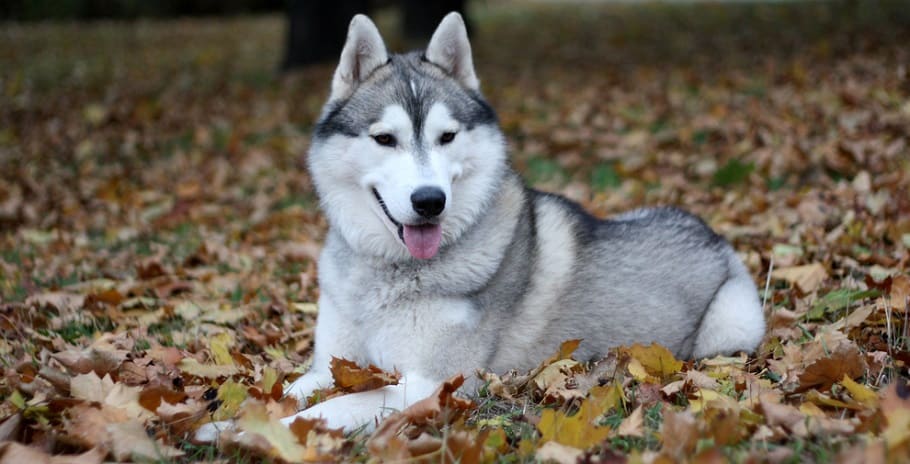
If your Husky is overweight, the following steps will help you motivate your puppy to lose weight and become fit:
- Reducing the amount of food – Huskies require a small amount of food daily compared to other dogs to stay fit and active. Reducing the amount that you are currently feeding your puppy will help them to lose weight. Consult with your vet to advise you on the amount of food you should feed them. Also, ensure that the food you are feeding your puppy is high in quality.
- Increase exercise – exercise is the most healthy and efficient method of helping your Husky lose weight. Start going for morning walks and jogs with your Husky and add more playtime to their daily schedule.
- Reduce treats – if your Husky gets a treat every day, it is time to cut them off because treats contribute to weight gain. Give your puppy treats in small amounts and when they truly earn it.
How Long Are Huskies Pregnant?
The average gestation period (pregnancy) of huskies is 62 days. The pregnancy is short because, in the wild, Mom Husky would be a huntress. By giving birth to puppies that are still developing, she is able to remain more mobile and hunt better.
Since it’s important for a lactating female to be well-nourished, she would ordinarily use this window to hunt quite intensively.
At the same time, the low level of development of the newborns also acts as an advantage, allowing Mom husky the ability to roam during the first weeks after their birth. The tiny pups simply can’t wander off and get lost, at least until they begin to take their first steps.
How Many Puppies Do Huskies Have?

The number of puppies in a litter depends on several factors including the health of the Husky Mom. On average, they will have between four and six puppies per litter, but the number can be larger or smaller. When there are many puppies in a litter, it’s especially important to make sure that the smallest ones are still getting access to their mom.
If you want to know exactly how many pups your husky female is carrying, you will need to take her for a visit to the vet. Since it is a good idea to have the female’s health checked during her pregnancy, this should not be an additional inconvenience.
Is My Husky Fat?
As with other dog breeds, it is fairly easy to see if your husky has a healthy weight. You should be able to feel the ribs beneath the skin when you run your hand along its side – needless to say, ribs shouldn’t actually be protruding!
When viewing your dog’s shape from above, you should see a distinct waist. If you can’t see a waistline, then your dog is not only fat but obese.
Still unsure? Use our Husky weight chart to double-check, or ask your vet for an opinion.
Huskies do need to burn a lot of calories – and that means regular exercise. In addition, some dogs will eat out of sheer boredom, or simply because the food is there, so if your husky is prone to pudginess, weigh out the dog’s food according to the guideline on the packet rather than allowing free feeding.
Is My Husky Underweight?
Owners of young huskies often worry that their dog is underweight. That’s because they tend to be rather lean during the time when they are gaining more height than weight. Remember, they continue to fill out after reaching their maximum height.
Once again, our Siberian Husky weight chart will help you to determine whether your husky is around the right weight for his or her age. However, if you’re worried, do take your pet for a checkup.
A vet will ensure that your dog is in good health and physical condition and can advise you if you are having problems with picky eating.
Husky Socialization
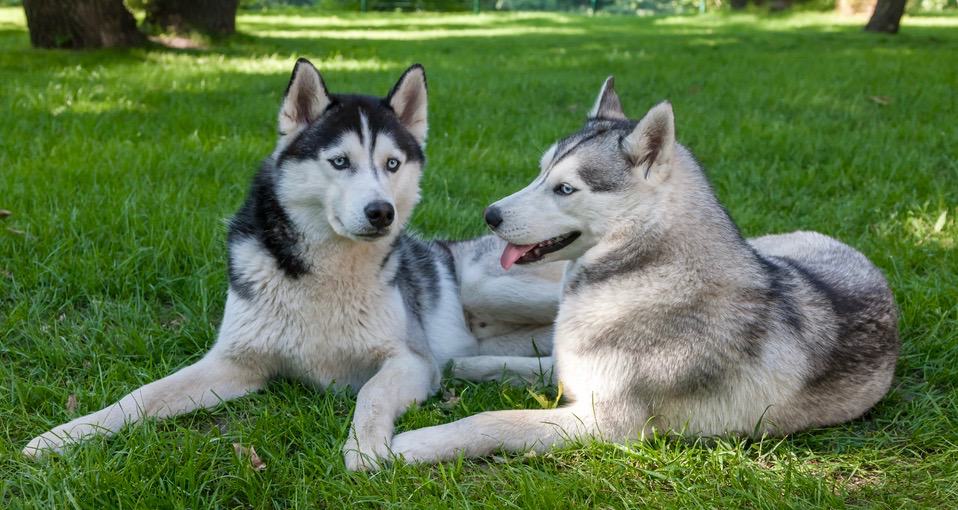
Although a well-raised Siberian Husky can be a very good pet, this breed was not initially intended to be a typical “family dog.” Certain instincts are still very strong in this breed, and that’s why socializing your puppy is so important, particularly with this breed.
Socialization should begin as soon as your puppy begins to explore the world around him. He must get used to other animals as well as meeting new people.
If he does not have this experience, he may become overprotective and, since that leads to aggressive behavior, the importance of socialization cannot be overstated. Puppy classes and visits from your friends will help a lot!
What Is The Life Expectancy Of Husky?
As a medium-sized breed, the Siberian Husky has a relatively good life expectancy of 12 to 14 or 15 years. Although purebred dogs often have specific genetic weaknesses, huskies were bred to be tough.
Their history as working dogs that were used in very harsh conditions means that only the fittest survived, and this heritage lives on in the breed.
When choosing a husky puppy, do select a reputable breeder and ask about family history. For example, hip dysplasia can be a problem in huskies.
With good care, it is even possible to go beyond the expected maximum lifespan. A healthy lifestyle throughout his younger years, good nutrition, and lots of exercise all contribute. It’s also good to adjust the food you give to your husky as he enters the later phase of his life.
What Is A Husky Temperament and Personality?
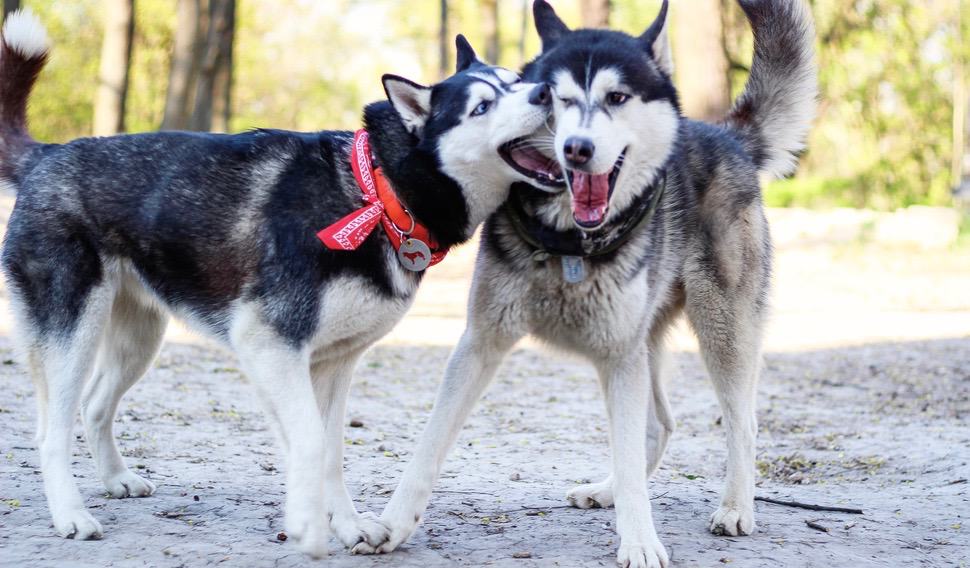
Siberian Huskies have the ideal temperament to match their origins. Thus, you can expect them to be full of an adventurous spirit and very alert to their surroundings. They can also be somewhat mischievous and obstinate.
Physical exercise, especially running, is this dog’s favorite thing. Unfortunately, that can lead to roaming habits, so be sure that your yard is properly fenced.
While huskies will mind their manners around pets whom they know to be part of the family, they may chase cats and be aggressive towards other dogs. Since dog-walking is a must for huskies, getting them used to meeting other dogs will spare you a lot of drama!
Huskies are intelligent and highly trainable, and they will thrive on interaction with their owners. However, neglect them at your peril.
A bored husky will find ways to keep himself entertained, and you might not be amused by the results. In short, this is NOT a dog for a pet owner who lacks time and energy for his or her dog.
Husky Genetics And Common Health Problems
Although huskies are generally strong dogs, they do have certain common health issues. As previously mentioned, hip dysplasia is one of them.
Since this problem is genetic, it is important to choose an ethical dog breeder who avoids breeding pups from parents with this particular issue.
Eye problems can be a genetic flaw in huskies. Cataracts can develop in dogs as young as one year old. They are not fatal, but they will affect eyesight and may even lead to total blindness.
Progressive Retinal Atrophy, a condition affecting the retina of the eye can also occur in relatively young dogs, leading to blindness.
Huskies are also known to develop glaucoma. This condition is treatable but not curable. If left untreated, it can lead to blindness.
Finally, the behavioural problems that can arise if a husky doesn’t get enough exercise and interaction can make him or her unmanageable. Sadly, such dogs must often be put to sleep, so don’t even consider getting a husky unless you’re ready to be a very active and energetic pet owner.
How Much Does A Husky Cost?
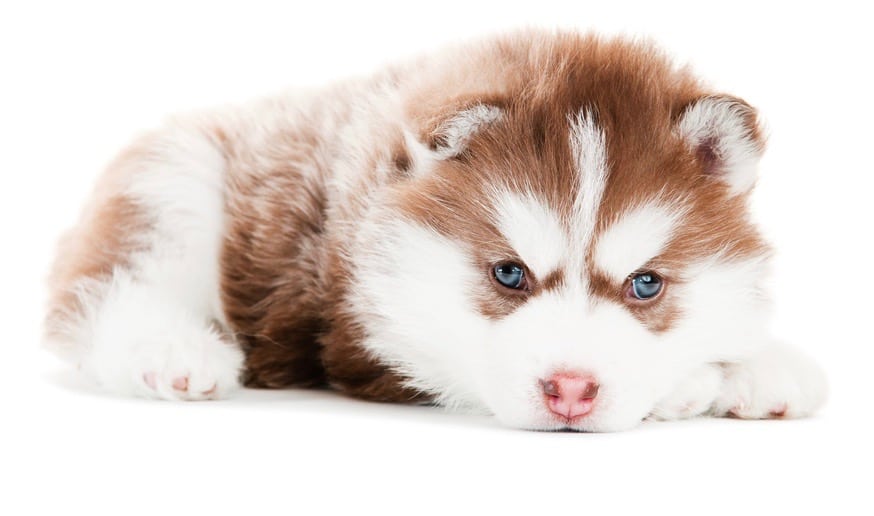
The cost of a pure-bred Siberian husky with papers is not low. However, an unregistered dog may either not be pure-bred or may come from genetically flawed stock.
The cost of a husky pup also depends on where in the world you may be, but in the US, you can expect to pay between 800 and 1,200 dollars for a puppy.
Do remember that your costs don’t end there. High-quality nutrition, parasite control, and vet visits also form part of the package. A survey found that the average annual cost of keeping a Husky is around 1,200 dollars a year.
What Factors Affect A Husky’s Growth?
Genetics
Just as one has larger and smaller people, so dogs can be genetically predisposed to have a certain height, weight and build. That’s why we list our puppy weight chart as a range, but in rare cases, particularly large or small dogs will even fall outside that.
Genetic inheritance depends on the specific combination of genes that come from both parents, so it’s possible for a smaller dog to have large parents. However, in general, big huskies will breed pups with a greater chance of being bigger than the norm.
Nutrition
Genetic potential is just what it says. Limiting factors, particularly during puppyhood can prevent a dog from reaching its maximum genetic potential.
Feeding your dog too much won’t make it get bigger than its genes allow, but feeding it too little, or giving it food that doesn’t contain sufficient nutrients, will mean that it will never reach it’s full potential size.
To help your Husky puppy to realize its potential, be sure to choose high-quality Husky puppy food that’s suitable for its life stage. Puppies, adults, and seniors all have different nutritional needs.
Physical Activity & Injury
Just as poor nutrition can prevent a puppy from reaching its full potential size, so other forms of physical stress during puppyhood can affect development. As you would expect, illness and injury are among these.
Muscle mass adds to the bulk and weight of a dog, so a lack of physical exercise will also affect its bulk. As we have noted, exercise is extremely important for huskies, and if your dog gets plenty of it, muscle development is a natural consequence.




